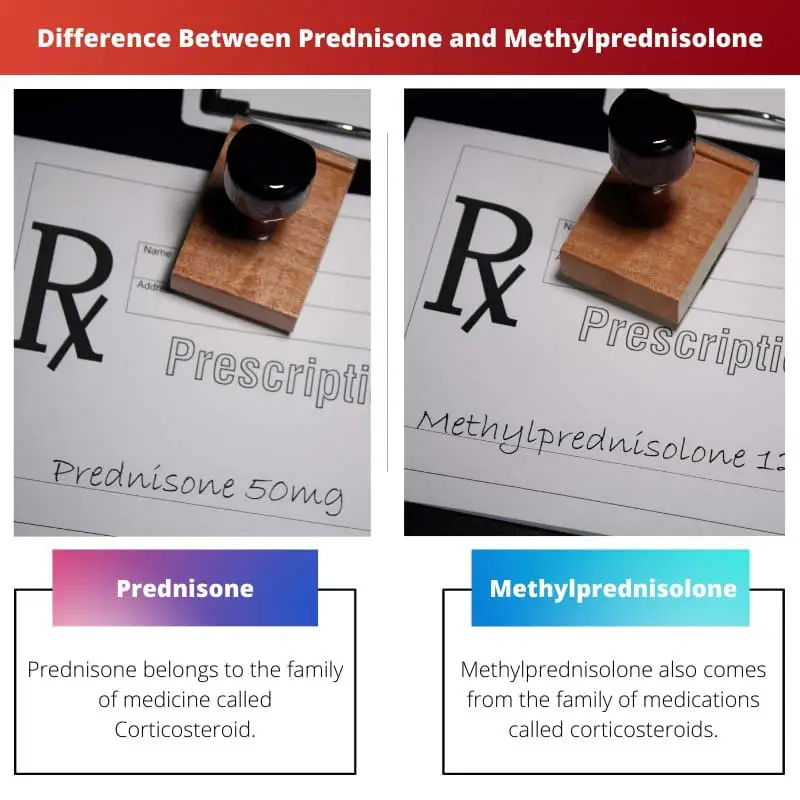Prednisone and Methylprednisone belong to the Corticosteroid class of medicine. They are prescribed by Doctors to reduce inflammation and reduce pain in the body by working on the immune system.
They are similar in price and their generic forms available but differ in their forms of intake, either as an oral tablet or injectable form.
Key Takeaways
- Both prednisone and methylprednisolone are corticosteroids used to treat various conditions, including allergies, asthma, and autoimmune disorders.
- Methylprednisolone tends to have a quicker onset of action and fewer side effects than prednisone, making it a preferred choice in certain clinical situations.
- Dosing and duration of treatment can vary between these two medications, with prednisone requiring a tapering regimen, while methylprednisolone can be administered in a single, high-dose injection.
Prednisone vs Methylprednisolone
Prednisone is a corticosteroid that is taken orally to reduce an overactive immune system. It is a prescribed medicine used to reduce inflammation caused by multiple sclerosis and arthritis. Methylprednisolone is a strong corticosteroid and an immunosuppressant used for chronic illnesses and severe inflammation.

Prednisone is a corticosteroid that is used to suppress the immune system and prevent the substances produced to cause inflammation.
It is also known as an anti-inflammatory and immunosuppressant medication that is induced in the form of injection and also in oral form.
Methylprednisolone is a corticosteroid that is used in treating various inflammations such as lupus, arthritis, colitis, allergic and gland disorders, ulcerative colitis, and psoriasis.
They are also used to prevent substances that cause inflammation in the body and prevent conditions that affect the organs of the body.
Comparison Table
| Parameters of Comparison | Prednisone | Methylprednisolone |
|---|---|---|
| Family of Medicine | Prednisone belongs to the family of medicine called Corticosteroid. | Methylprednisolone also comes from the family of medications called corticosteroids. |
| Brand | Prednisone is available in a brand named Rayos. The most common obtainable brand for prednisone is only one. | Methylprednisolone is available in brands named Medrol, Depo-Medrol, and Solu-Medrol. |
| Intake methods | Prednisone is available as an oral tablet and oral liquid form. The intake of oral tablets should not be chewed and taken as a whole tablet while the liquid form is advised for children. | Methylprednisolone is available as an oral tablet and injectable form which depends on the condition required. |
| Approved by FDA | Prednisone is approved by FDA in 1955. | Methylprednisolone is approved by FDA in 1957 |
| Strong | Prednisone is less strong than Methylprednisolone. So it is available in tablet and liquid form which is taken only for the prescribed periods. | Methylprednisolone is stronger than Prednisone. So the prescription of Methylprednisolone is only advised for severe inflammatory diseases. |
What is Prednisone?
Prednisone is a corticosteroid used as an anti-inflammatory and immunosuppressant that prevents substances from causing inflammation.
Prednisone is used in treating inflammatory conditions such as allergic disorders, skin disorders, arthritis, colitis, lupus, ulcerative disorders, psoriasis, and breathing disorders.
Prednisone is restricted for people who are allergic to its medication or any fungal infection.
Other precautions before intake of Prednisone include diarrhoea illness, liver, kidney, and heart-related diseases, thyroid disorder, diabetes, malaria history, tuberculosis, osteoporosis, myasthenia gravis, and other depression or mental illness.
Prednisone can affect newborn babies by indicating a low weight when Prednisone is taken during the trimester period. Intake of prednisone can be spread into breast milk and harm nursing newborns.
It can affect the child’s growth and immune system as well due to the intake of Prednisone.
Prednisone requires a systematic intake of it. Changing the dosage of Prednisone at regular intervals as per the doctor’s instruction and prescription is very crucial.
Taking Prednisone for a longer period than prescribed can cause adverse effects. The dosage needs to be changed when there is unusual stress or mental illness observed.

What is Methylprednisolone?
Methylprednisolone is a corticosteroid that prevents the release of substances causing inflammation in the body.
It is also used to prevent various inflammatory illnesses such as arthritis, lupus, psoriasis, ulcerative colitis, allergic and gland disorders, and it also prevents conditions that affect the organs of the body such as eyes, skin, lungs, stomach, blood cells, and nervous system.
Methylprednisolone is not prescribed if a person is suffering from a fungal infection.
Long-term intake of Methylprednisolone for more than the prescribed duration can weaken the immune system of the body resulting in various other side effects. Sudden withdrawal of Methylprednisolone can cause withdrawal symptoms that are not advisable.
Methylprednisolone intake should be precautionary, and a few checks need to be done before starting the medication.
It has to be taken when a person is not allergic to fungal injection and methylprednisolone, and a few other pre-checks would include thyroid disorder, herpes infection, ulcerative colitis, depression, mental illness, high blood pressure, multiple sclerosis, and osteoporosis.
Methylprednisolone overdosage can cause thinning skin, bruising, an increase in body fat composition, an increase in acne and facial hair, menstrual problems, and impotence.
It is advised to avoid receiving live vaccines during the methylprednisolone intake period because it may not protect from the disease for which live vaccine is taken.

Main Differences Between Prednisone and Methylprednisolone
- Prednisone is approved by FDA in 1955, whereas Methylprednisolone was FDA-approved in 1957.
- Prednisone brand names include Rayos, whereas Methylprednisolone brand names include Medrol, Depo-Medrol, and Solu-Medrol.
- Prednisone is available in the form of an oral tablet and oral liquid form, whereas Methylprednisolone is available in an oral tablet and injectable form.
- Prednisone is less strong when compared to Methylprednisolone.
- Prednisone is an anti-inflammatory and immunosuppressant medication, whereas Methylprednisolone is used to prevent the release of substances that cause inflammation.
- Prednisone causes side effects when taken in an improper manner, side effects include damage to adrenal and pituitary gland functioning, whereas Methylprednisolone causes suppression of the hypothalamic adrenal pituitary axis when taken in the long term more than prescribed.





